Impact of the Pre-Dehydration and Drying Methods on the Mass Transfer and Quality Attributes of Yak Milk Casein
Abstract
1. Introduction
2. Materials and Methods
2.1. Preparation and Drying of Yak Milk Casein
2.2. Moisture Ratio
2.3. Mathematical Modeling of Drying
2.4. Determination of Gross Composition
2.5. Determination of Color
2.6. 5-Hydroxymethylfurfural
2.7. Measurement of Fat Oxidation
2.8. Solubility
2.9. Emulsifying Activity
2.10. Statistical Analyses
3. Result and Discussion
3.1. Drying Kinetics
3.2. Mathematical Modeling
3.3. Gross Composition
3.4. Solubility and Emulsifying Activity
3.5. Color Attributes
3.6. Fat Oxidation
3.7. Correlation Analysis
4. Conclusions
Supplementary Materials
Author Contributions
Funding
Institutional Review Board Statement
Informed Consent Statement
Data Availability Statement
Conflicts of Interest
References
- Cui, N.; Wen, P.C.; Liang, Q.; Liu, H.N.; Zhang, W.B.; Wang, P.J.; Guo, H.Y.; Ren, F.Z. Chemical composition of yak colostrum and transient milk. J. Anim. Physiol. Anim. Nutr. 2014, 99, 825–833. [Google Scholar] [CrossRef] [PubMed]
- Liu, H.N.; Ren, F.Z.; Jiang, L.; Ma, Z.L.; Qiao, H.J.; Zeng, S.S.; Gan, B.Z.; Guo, H.Y. Fatty acid profile of yak milk from the Qinghai-Tibetan Plateau in different seasons and for different parities. J. Dairy Sci. 2011, 94, 1724–1731. [Google Scholar] [CrossRef] [PubMed]
- Liu, H.N.; Zhang, C.; Zhang, H.; Guo, H.Y.; Wang, P.J.; Zhu, Y.B.; Ren, F.Z. pH treatment as an effective tool to select the functional and structural properties of yak milk caseins. J. Dairy Sci. 2013, 96, 5494–5500. [Google Scholar] [CrossRef] [PubMed]
- Ihara, K.; Hirota, M.; Akitsu, T.; Urakawa, K.; Abe, T.; Sumi, M.; Okawa, T.; Fujii, T. Effects of emulsifying components in the continuous phase of cream on the stability of fat globules and the physical properties of whipped cream. J. Dairy Sci. 2015, 98, 2875–2883. [Google Scholar] [CrossRef] [PubMed]
- Rehan, F.; Ahemad, N.; Gupta, M. Casein nanomicelle as an emerging biomaterial—A comprehensive review. Colloids Surface B. 2019, 179, 280–292. [Google Scholar] [CrossRef] [PubMed]
- Kazimierska, K.; Kalinowska-Lis, U. Milk proteins—their biological activities and use in cosmetics and dermatology. Molecules 2021, 26, 3253. [Google Scholar] [CrossRef] [PubMed]
- Lin, K.; Zhang, L.W.; Han, X.; Meng, Z.X.; Zhang, J.M.; Wu, Y.F.; Cheng, D. Quantitative structure-activity relationship modeling coupled with molecular docking analysis in screening of angiotensin Ι-converting enzyme inhibitory peptides from Qula casein hydrolysates obtained by two-enzyme combination hydrolysis. J. Agric. Food Chem. 2018, 66, 3221–3228. [Google Scholar] [CrossRef] [PubMed]
- Wang, J.; Wang, L.N.; Wang, L.L.; Han, L.; Chen, L.H.; Tang, S.H.; Wen, P.C. Response surface optimization of solar drying conditions and the effect on the quality attributes and drying characteristics of Qula casein. Foods 2022, 11, 2406. [Google Scholar] [CrossRef] [PubMed]
- Mao, X.Y.; Ni, J.R.; Sun, W.L.; Hao, P.P.; Fan, L. Value-added utilization of yak milk casein for the production of angiotensin-I-converting enzyme inhibitory peptides. Food Chem. 2007, 103, 1282–1287. [Google Scholar] [CrossRef]
- Jiang, J.L.; Chen, S.W.; Ren, F.Z.; Luo, Z.; Zeng, S.S. Yak milk casein as a functional ingredient: Preparation and identification of angiotensin-I-converting enzyme inhibitory peptides. J. Dairy Res. 2007, 74, 18–25. [Google Scholar] [CrossRef] [PubMed]
- Yu, X.L.; Zielinska, M.; Ju, H.Y.; Mujumdar, A.S.; Duan, X.; Gao, Z.J.; Xiao, H.W. Multistage relative humidity control strategy enhances energy and exergy efficiency of convective drying of carrot cubes. Int. J. Heat Mass. Transf. 2020, 149, 119231. [Google Scholar] [CrossRef]
- Liu, Z.L.; Xie, L.; Zielinska, M.; Pan, Z.L.; Deng, L.Z.; Zhang, J.S.; Gao, L.; Wang, S.Y.; Zheng, Z.A.; Xiao, H.W. Improvement of drying efficiency and quality attributes of blueberries using innovative far-infrared radiation heating assisted pulsed vacuum drying (FIR-PVD). Innov. Food Sci. Emerg. 2022, 77, 102948. [Google Scholar] [CrossRef]
- Ai, Z.P.; Xie, Y.K.; Li, X.Y.; Lei, D.W.; Ambrose, K.; Liu, Y.H. Revealing color change and drying mechanisms of pulsed vacuum steamed Cistanche deserticola through bioactive components, microstructural and starch gelatinization properties. Food Res. Int. 2022, 162, 112079. [Google Scholar] [CrossRef] [PubMed]
- Jiang, D.L.; Xiao, H.W.; Zielinska, M.; Zhu, G.F.; Bai, T.Y.; Zheng, Z.A. Effect of pulsed vacuum drying on drying kinetics and quality of roots of Panax notoginseng (Burk.) F. H. Chen (Araliaceae). Dry Technol. 2020, 16, 2234–2251. [Google Scholar] [CrossRef]
- Pyrka, I.; Mantzouridou, F.T.; Nenadis, N. Optimization of olive leaves’ thin layer, intermittent near-infrared-drying. Innov. Food Sci. Emerg. 2023, 84, 103264. [Google Scholar] [CrossRef]
- Biswas, R.; Hossain, M.A.; Zzaman, W. Thin layer modeling of drying kinetics, rehydration kinetics and color changes of osmotic pre-treated pineapple (Ananas comosus) slices during drying: Development of a mechanistic model for mass transfer. Innov. Food Sci. Emerg. 2022, 80, 103094. [Google Scholar] [CrossRef]
- Mota, C.L.; Luciano, C.; Dias, A.; Barroca, M.J.; Guiné, R.P.F. Convective drying of onion: Kinetics and nutritional evaluation. Food Bioprod. Process. 2010, 88, 115–123. [Google Scholar] [CrossRef]
- Ertekin, C.; Firat, M.Z. A comprehensive review of thin-layer drying models used in agricultural products. Crit. Rev. Food Sci. 2017, 57, 701–717. [Google Scholar] [CrossRef]
- Vijayan, S.; Arjunan, T.V.; Kumar, A. Mathematical modeling and performance analysis of thin layer drying of bitter gourd in sensible storage based indirect solar dryer. Innov. Food Sci. Emerg. 2016, 36, 59–67. [Google Scholar] [CrossRef]
- Cao, F.; Zhang, R.; Tang, J.; Li, F.; Jiao, Y. Radio frequency combined hot air (RF-HA) drying of tilapia (Oreochromis niloticus L.) fillets: Drying kinetics and quality analysis. Innov. Food Sci. Emerg. 2021, 74, 102791. [Google Scholar] [CrossRef]
- Wang, J.; Law, C.L.; Nema, P.K.; Zhao, J.H.; Liu, Z.L.; Deng, L.Z.; Gao, Z.J.; Xiao, H.W. Pulsed vacuum drying enhances drying kinetics and quality of lemon slices. J. Food Eng. 2018, 224, 129–138. [Google Scholar] [CrossRef]
- AOAC International. Official Methods of Analysis, 16th ed.; AOAC International: Rockville, MD, USA, 1997. [Google Scholar]
- Wang, J.; Chen, Y.X.; Zhao, L.L.; Fang, X.M.; Zhang, Y. Lipidomics reveals the molecular mechanisms underlying the changes in lipid profiles and lipid oxidation in rape bee pollen dried by different methods. Food Res. Int. 2022, 162, 112104. [Google Scholar] [CrossRef] [PubMed]
- Zhou, Y.H.; Pei, Y.P.; Sutar, P.P.; Liu, D.H.; Deng, L.Z.; Duan, X.; Liu, Z.L.; Xiao, H.W. Pulsed vacuum drying of banana: Effects of ripeness on drying kinetics and physicochemical properties and related mechanism. LWT 2022, 161, 113362. [Google Scholar] [CrossRef]
- Wang, J.; Mu, W.S.; Fang, X.M.; Mujumdar, A.S.; Yang, X.H.; Xue, L.Y.; Xie, L.; Xiao, H.W.; Gao, Z.J.; Zhang, Q. Pulsed vacuum drying of Thompson seedless grape: Effects of berry ripeness on physicochemical properties and drying characteristic. Food Bioprod. Process. 2017, 106, 117–126. [Google Scholar] [CrossRef]
- Xie, L.; Zheng, Z.A.; Mujumdar, A.S.; Fang, X.M.; Wang, J.; Zhang, Q.; Ma, Q.; Xiao, H.W.; Liu, Y.H.; Gao, Z.J. Pulsed vacuum drying (PVD) of wolfberry: Drying kinetics and quality attributes. Dry. Technol. 2018, 22, 1501–1514. [Google Scholar] [CrossRef]
- Hnin, K.K.; Zhang, M.; Devahastin, S.; Wang, B. Combined infrared freeze drying and infrared drying of rose-flavored yogurt melts-Effect on product quality. Food Bioprocess Technol. 2020, 13, 1356–1367. [Google Scholar] [CrossRef]
- Malakar, S.; Alam, M.; Arora, V.K. Evacuated tube solar and sun drying of beetroot slices: Comparative assessment of thermal performance, drying kinetics, and quality analysis. Sol. Energy 2022, 233, 246–258. [Google Scholar] [CrossRef]
- Sahoo, M.; Titikshya, S.; Aradwad, P.; Kumar, V.; Naik, S.N. Study of the drying behaviour and color kinetics of convective drying of yam (Dioscorea hispida) slices. Ind. Crops Prod. 2022, 176, 114258. [Google Scholar] [CrossRef]
- Wang, M.Q.; Yuan, X.W.; Zheng, Y.; Wu, Z.Y.; Li, H.B.; Li, H.J.; Yu, J.H. Maillard reaction indicators formation, changes and possible intake in infant formula produced by different thermal treatments during domestic use. Food Chem. 2022, 395, 133576. [Google Scholar] [CrossRef] [PubMed]
- Akillioglu, H.G.; Chatterton, D.E.W.; Lund, M.N. Maillard reaction products and amino acid cross-links in liquid infant formula: Effects of UHT treatment and storage. Food Chem. 2023, 396, 133687. [Google Scholar] [CrossRef] [PubMed]
- Zhao, X.X.; Guo, Y.P.; Zhang, Y.M.; Pang, X.Y.; Wang, Y.N.; Lv, J.P.; Zhang, S.W. Effects of different heat treatments on Maillard reaction products and volatile substances of camel milk. Front. Nutr. 2023, 10, 1072261. [Google Scholar] [CrossRef] [PubMed]
- Li, H.B.; Zhang, Y.Y.; Jiang, Y.L.; Li, C.; Zhao, Y.; Li, C.S.; DuoJie, R.Q.; Zulewska, J.; Li, H.J. Application of tea polyphenols as additives in brown fermented milk: Potential analysis of mitigating Maillard reaction products. J. Dairy Sci. 2023, 10, 3168. [Google Scholar] [CrossRef] [PubMed]
- Zhang, H.; Wang, P.J.; Lei, X.G.; Yang, H.J.; Zhang, L.D.; Ren, F.Z.; Zheng, L.M. Spectroscopic evaluation of effects of heat treatments on the structures and emulsifying properties of caseins. Spectrosc. Spect. Anal. 2013, 33, 1275–1280. [Google Scholar]
- Poojary, M.M.; Lund, M.N. Chemical stability of proteins in foods: Oxidation and the Maillard reaction. Annu. Rev. Food Sci. Technol. 2022, 13, 35–58. [Google Scholar] [CrossRef] [PubMed]
- Li, Y.; Jia, X.D.; Wang, Z.J.; He, Z.Y.; Zeng, M.M.; Chen, J. Characterizing changes in Maillard reaction indicators in whole milk powder and reconstituted low-temperature pasteurized milk under different preheating conditions. J. Food Sci. 2021, 87, 193–205. [Google Scholar] [CrossRef] [PubMed]
- Li, H.B.; Zhang, Y.Y.; Li, C.S.; Xu, S.Y.; Song, W.B.; Li, H.J.; Yu, J.H. Content and evolution of Maillard reaction products in commercial brown fermented milk during storage. Int. Dairy J. 2022, 129, 105343. [Google Scholar] [CrossRef]
- Barreira, C.F.T.; de Oliveira, V.S.; Chavez, D.W.H.; Gamallo, O.D.; Castro, R.N.; Damasceno, P.C.; Sawaya, A.C.H.F.; Ferreira, M.D.; Sampaio, G.R.; Torres, E.A.F.D.; et al. The impacts of pink pepper (Schinus terebinthifolius Raddi) on fatty acids and cholesterol oxides formation in canned sardines during thermal processing. Food Chem. 2022, 403, 134347. [Google Scholar] [CrossRef] [PubMed]
- Zhang, M.H.; Xie, D.G.; Wang, D.Y.; Xu, W.M.; Zhang, C.H.; Li, P.P.; Sun, C. Lipidomic profile changes of yellow-feathered chicken meat during thermal processing based on UPLC-ESI-MS approach. Food Chem. 2022, 399, 133977. [Google Scholar] [CrossRef] [PubMed]
- Sajib, M.; Albers, E.; Langeland, M.; Undeland, I. Understanding the effect of temperature and time on protein degree of hydrolysis and lipid oxidation during ensilaging of herring (Clupea harengus) filleting co-products. Sci. Rep. 2020, 10, 9590. [Google Scholar] [CrossRef] [PubMed]
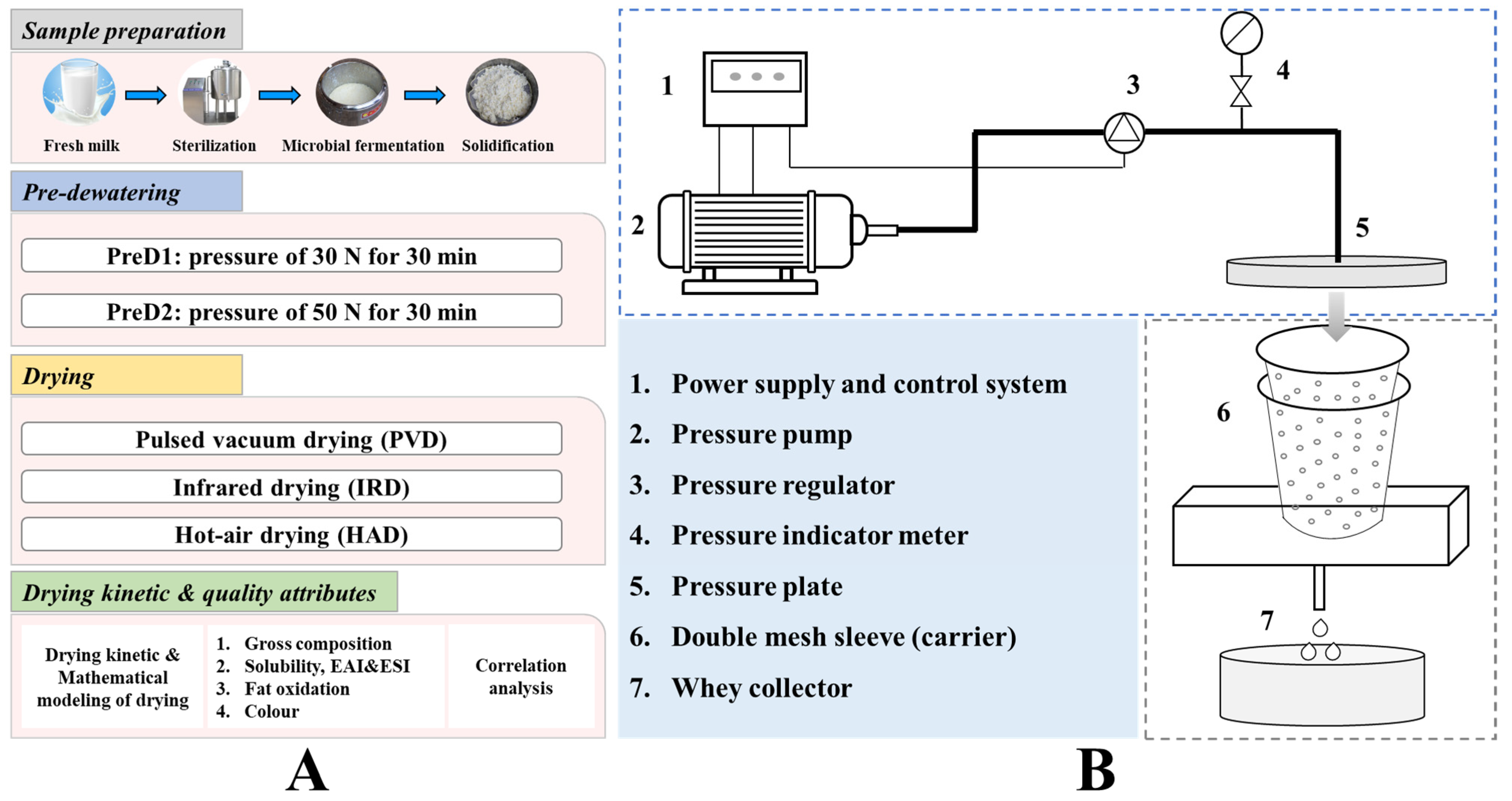


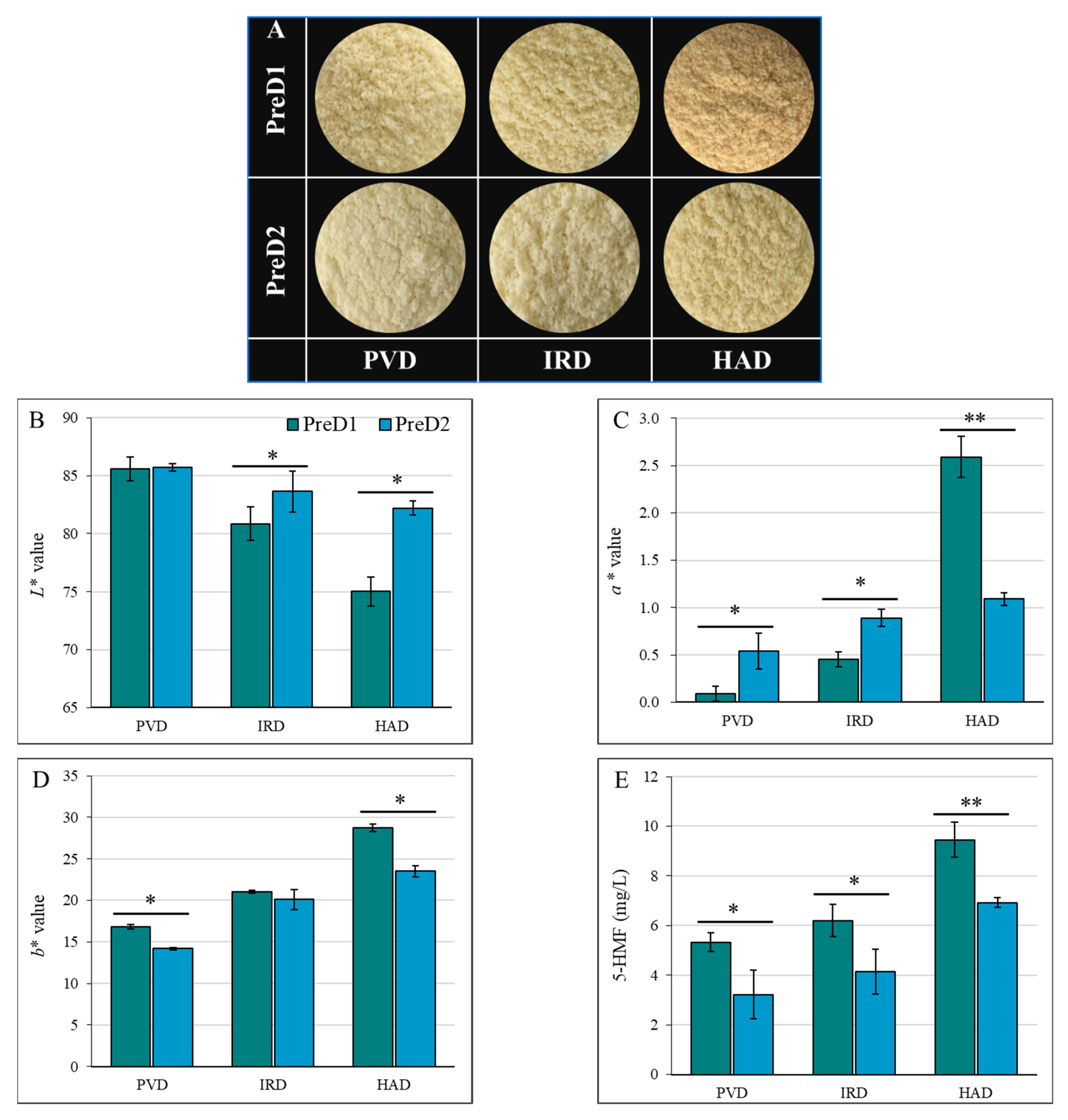
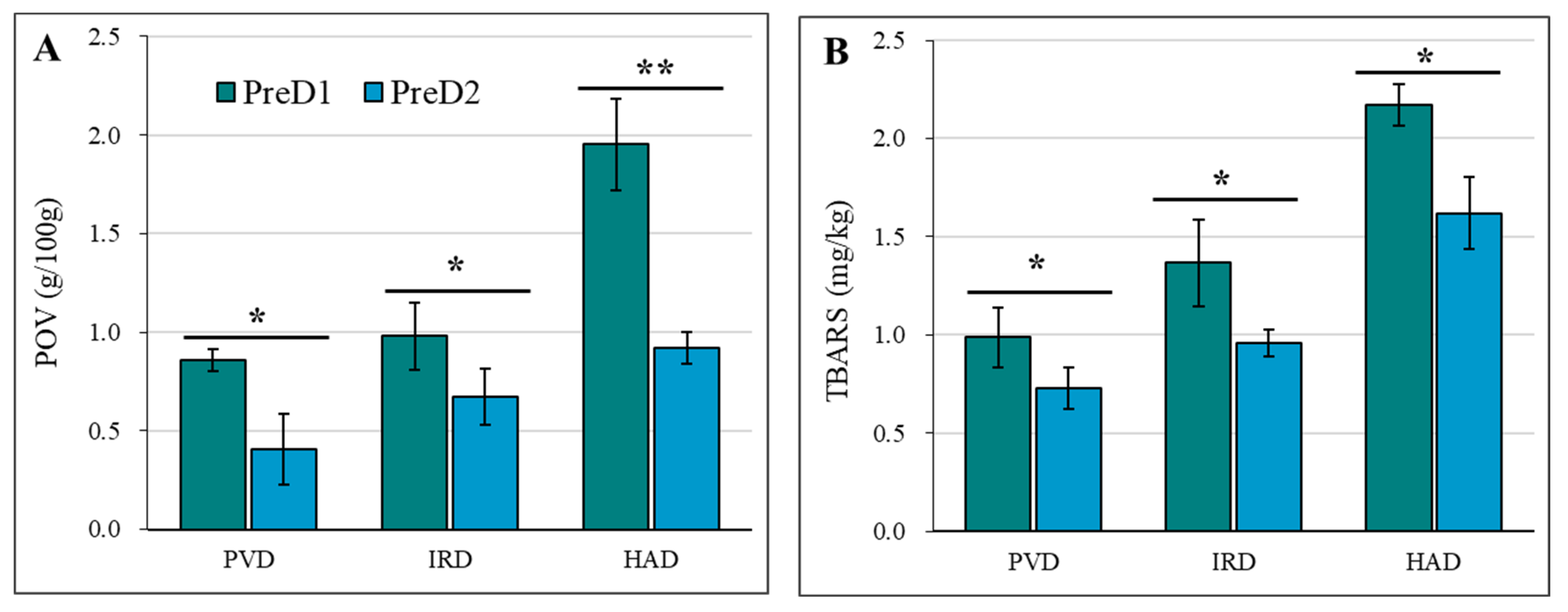
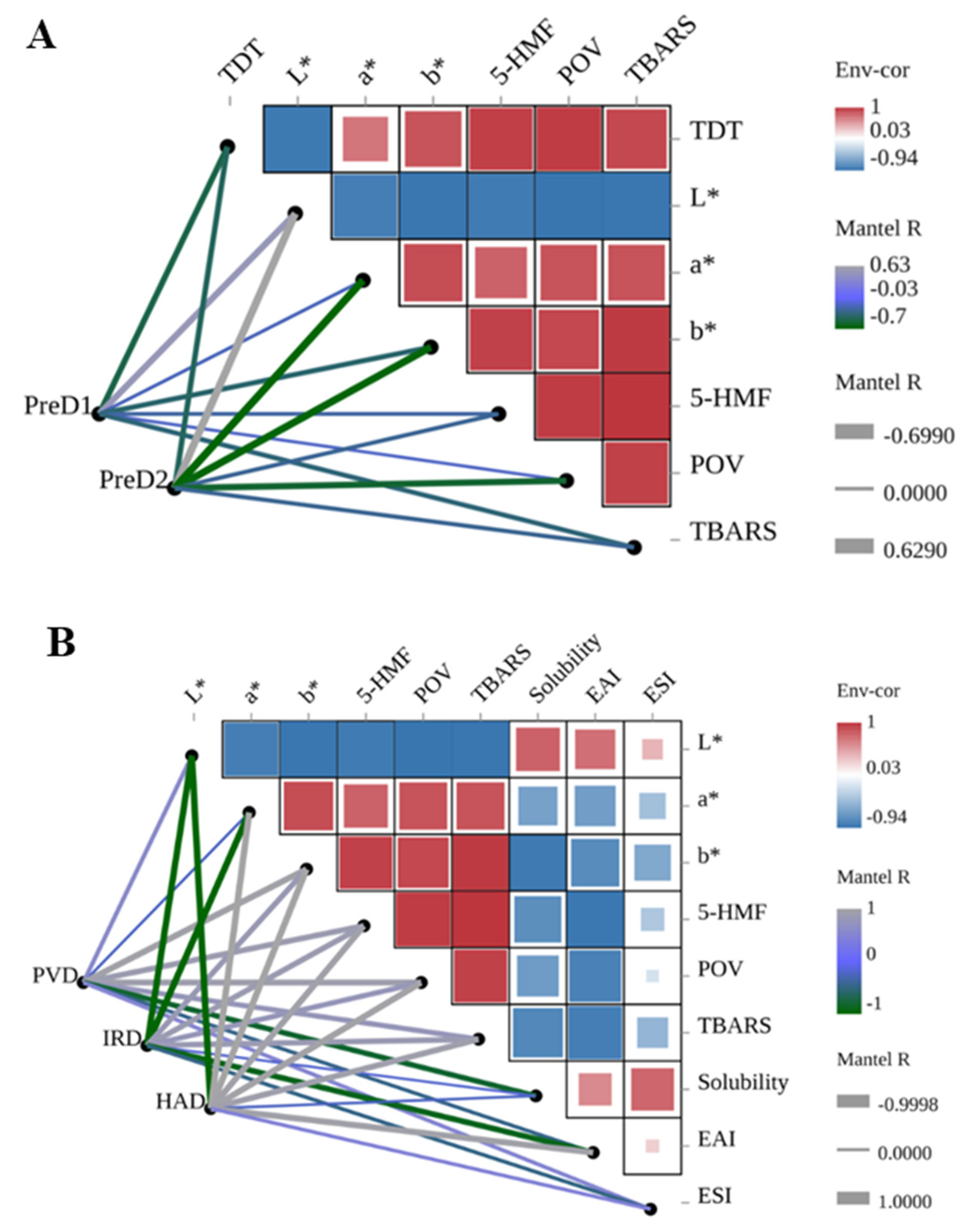
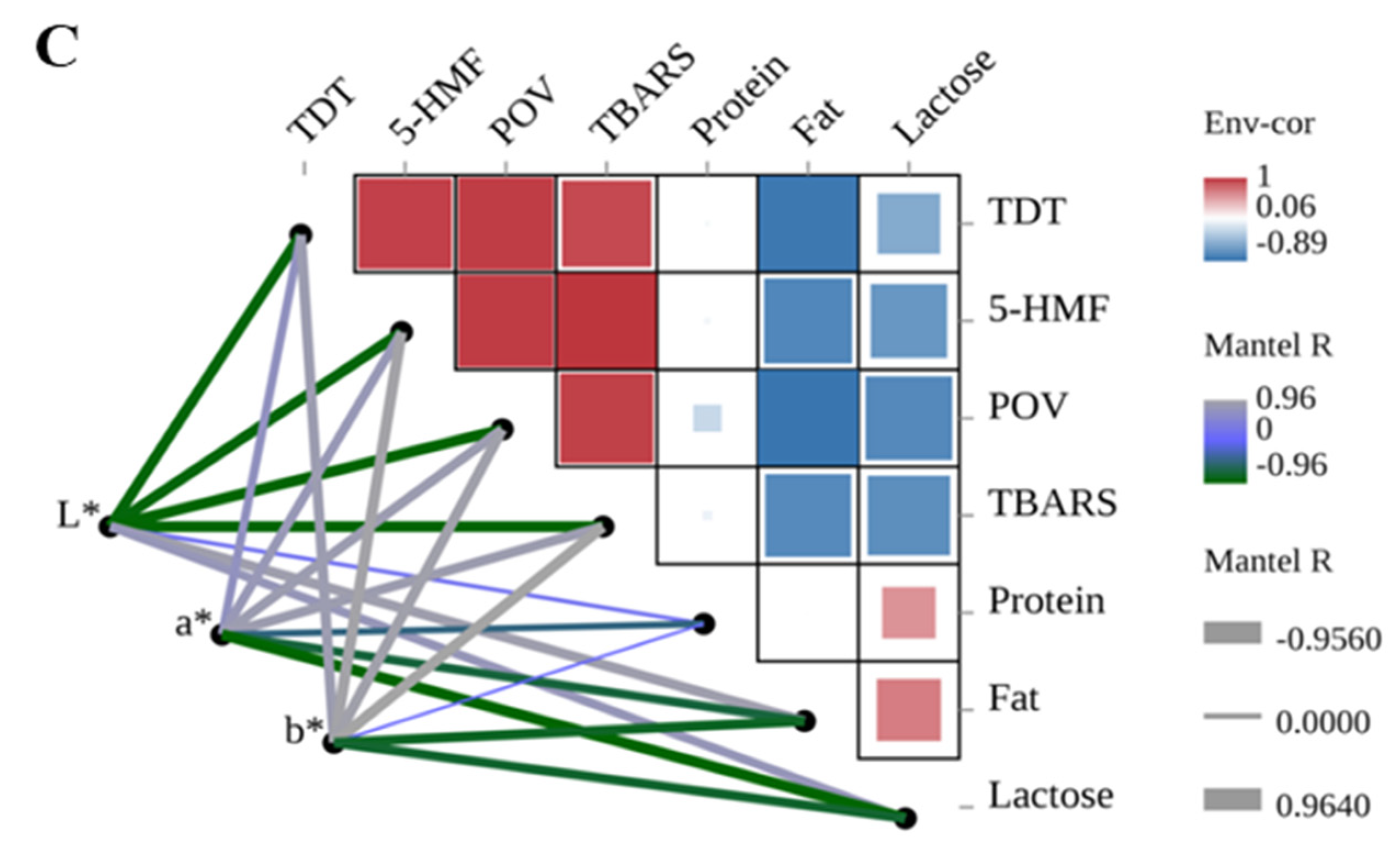
| No. | Model Name | Model | References |
|---|---|---|---|
| 1 | Page | [16] | |
| 2 | Newton | [17] | |
| 3 | Henderson and Pabis | [18] | |
| 4 | Logarithmic | [19] | |
| 5 | Verma | [16] | |
| 6 | Two-term exponential | [20] | |
| 7 | Weibull | [21] | |
| 8 | Midilli–Kucuk | [19] |
| Pre-Dewatering | Drying Method | Gross Composition (g/100 g Dry Basis) | |||
|---|---|---|---|---|---|
| Protein | Fat | Lactose | Ash | ||
| Control | 72.03 ± 1.71 a | 6.11 ± 0.29 a | 5.68 ± 0.44 a | 5.35 ± 0.99 | |
| PreD1 | PVD | 71.42 ± 2.56 bc | 6.32 ± 0.23 bc | 5.40 ± 0.19 a | 5.27 ± 0.15 |
| IRD | 71.63 ± 1.09 bc | 5.16 ± 0.62 bc | 5.51 ± 0.32 a | 5.31 ± 0.17 | |
| HAD | 71.15 ± 1.20 c | 4.80 ± 0.31 c | 4.69 ± 0.70 b | 5.27 ± 0.11 | |
| PreD2 | PVD | 71.14 ± 2.17 c | 5.62 ± 0.20 ab | 5.34 ± 0.21 ab | 5.23 ± 0.19 |
| IRD | 71.41 ± 2.61 bc | 5.19 ± 1.03 bc | 5.13 ± 0.09 ab | 5.25 ± 0.28 | |
| HAD | 71.54 ± 1.46 bc | 5.43 ± 0.33 bc | 5.17 ± 0.26 ab | 5.18 ± 0.23 | |
| Pre-Dewatering | Drying Method | Solubility (%) | EAI (m2·g−1) | ESI (min) |
|---|---|---|---|---|
| PreD1 | PVD | 91.27 ± 1.01 b | 6.14 ± 0.09 bcd | 13.45 ± 0.75 a |
| IRD | 85.70 ± 1.82 c | 6.40 ± 0.43 abc | 12.42 ± 1.34 ab | |
| HAD | 83.60 ± 1.95 c | 5.68 ± 0.46 d | 12.38 ± 0.62 ab | |
| PreD2 | PVD | 94.27 ± 1.66 a | 6.68 ± 0.15 a | 12.96 ± 0.72 ab |
| IRD | 86.33 ± 2.10 c | 6.64 ± 0.19 ab | 12.20 ± 0.99 ab | |
| HAD | 84.27 ± 1.26 c | 5.96 ± 0.08 cd | 11.37 ± 1.09 b |
Disclaimer/Publisher’s Note: The statements, opinions and data contained in all publications are solely those of the individual author(s) and contributor(s) and not of MDPI and/or the editor(s). MDPI and/or the editor(s) disclaim responsibility for any injury to people or property resulting from any ideas, methods, instructions or products referred to in the content. |
© 2024 by the authors. Licensee MDPI, Basel, Switzerland. This article is an open access article distributed under the terms and conditions of the Creative Commons Attribution (CC BY) license (https://creativecommons.org/licenses/by/4.0/).
Share and Cite
Wang, D.; Cao, Z.; Gao, Y.; Yang, L.; Zhao, L. Impact of the Pre-Dehydration and Drying Methods on the Mass Transfer and Quality Attributes of Yak Milk Casein. Foods 2024, 13, 1062. https://doi.org/10.3390/foods13071062
Wang D, Cao Z, Gao Y, Yang L, Zhao L. Impact of the Pre-Dehydration and Drying Methods on the Mass Transfer and Quality Attributes of Yak Milk Casein. Foods. 2024; 13(7):1062. https://doi.org/10.3390/foods13071062
Chicago/Turabian StyleWang, Dong, Zhi Cao, Yumei Gao, Lin Yang, and Lili Zhao. 2024. "Impact of the Pre-Dehydration and Drying Methods on the Mass Transfer and Quality Attributes of Yak Milk Casein" Foods 13, no. 7: 1062. https://doi.org/10.3390/foods13071062
APA StyleWang, D., Cao, Z., Gao, Y., Yang, L., & Zhao, L. (2024). Impact of the Pre-Dehydration and Drying Methods on the Mass Transfer and Quality Attributes of Yak Milk Casein. Foods, 13(7), 1062. https://doi.org/10.3390/foods13071062






